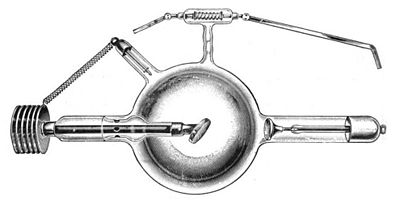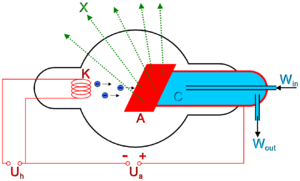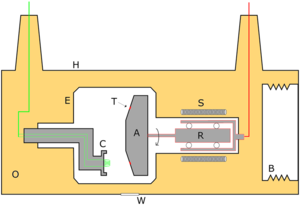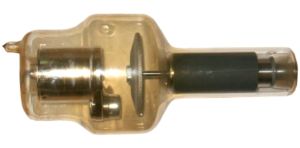Xray Tube
Crookes tube
| Historically, the first X-ray tube was invented by Sir William Crookes. It was used to make a visible fluorescence on minerals. The Crookes tube is also called discharge tube or cold cathode tube. It is a glass bulb with around a thousandth of sea-level atmospheric pressure of air (approximately 100 pascals or 1 torr). It contains an aluminum cathode with a curved shape to concentrate the electron flow on the anode, or "target". The remaining electrode is the anticathode. In most designs it had an aluminium plate on it similar to the cathode, but not curved. In later designs the position of the anode and anticathode on the bulb was interchanged, but the actual anode target remained in the same place. In operation, the residual gas in the tube would be adsorbed by the glass and the metal electrodes leading to a reduction in the x-ray output. The side tube (at the top in the illustration) contained a few mica sheets which would release small amounts of gas when heated by an electric heater wire. This would be heated while the tube operated until the output was restored. A high voltage is made between the electrodes; this induces an ionization of the residual air, and thus an electron flow or "discharge" from the cathode to the anode. When these electrons hit the target, they are slowed down, producing the X-rays (Bremsstrahlung). This tube can not produce X-rays continuously. It is no longer used on modern devices. Tubes of this type were rarely screened from the operator as the effects of repeated exposure of x-rays to tissue was unknown. | Crookes X-ray tube from early 1900s. The cathode is on the right, the anode is in the center with attached heat sink at left. The device at top is used to regulate the gas pressure. |
Coolidge tube
| The Crookes tube was improved by William Coolidge in 1913. The Coolidge tube, also called hot cathode tube, is the most widely used. It works with a very good quality vacuum (10-6 Torr). In the Coolidge tube, the electrons are produced by thermionic effect from a tungsten filament heated by an electric current. The filament is the cathode of the tube. The high voltage potential is between the cathode and the anode, the electrons are then accelerated and hit the anode. There are two designs: end-window tubes and side-window tubes. In the end-window tubes, the filament is around the anode and the electrons have a curved path. Side-window tubes have
|
|
Modern rotating anode tube
| The rotating anode tube is an improvement of the Coolidge tube. Because X-ray production is very inefficient (99% of incident energy is converted to heat) the dissipation of heat at the focal spot is one of the main limitations on the power which can be applied. By sweeping the anode past the focal spot the heat load can be spread over a larger area, greatly increasing the power rating. The anode consists of a disc with an annular target close to the edge. The anode disc is supported on a long stem which is supported by bearings within the tube. The anode can then be rotated by electromagnetic induction from a series of stator windings outside the evacuated tube. Because the entire anode assembly has to be contained within the evacuated tube, heat removal is a serious problem, further exacerbated by the higher power rating available. Direct cooling by conduction or convection , as in the Coolidge tube, is difficult. In most tubes, the anode is suspended on ball bearings with silver powder lubrication which provide almost negligible cooling by conduction. A recent development has been liquid gallium lubricated fluid dynamic bearings which can withstand very high temperatures without contaminating the tube vacuum. The large bearing contact surface and metal lubricant provide an effective method for conduction of heat from the anode. The anode must be constructed of high temperature materials. The focal spot temperature can reach 2500°C during an exposure, and the anode assembly can reach 1000°C following a series of large exposures. Typical materials are a tungsten-rhenium target on a molybdenum core, backed with graphite. The rhenium makes the tungsten more ductile and resistant to wear from impact of the electron beams. The molybdenum conducts heat from the target. The graphite provides thermal storage for the anode, and minimizes the rotating mass of the anode. |
<a class="external" href="http://en.wikipedia.org/wiki/Image:Rontgenbuis-draaianode.jpg" rel="nofollow" target="_blank" title="Enlarge"> |



